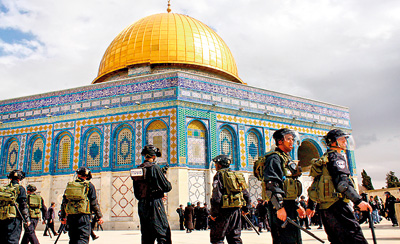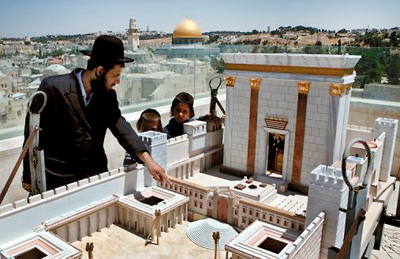JERUSALEM, (AFP) - "No singing. No dancing. No praying. No animals," reads the curiously worded sign greeting visitors heading up the rickety wooden ramp to the Al-Aqsa mosque compound in Jerusalem's Old City.
For the non-Jewish visitor, it takes a few moments for the significance of the words to sink in.
But for Jews, who revere the site as the former location of the First and Second Temples, it is a bitter reminder of a harsh reality -- they are not allowed to worship at Judaism's holiest site.
Known to Jews as the Temple Mount, the plaza is referred to by Muslims as Al-Haram Al-Sharif and is considered the third holiest site in Islam.
 |
| Israeli policemen stand guard near the Dome of the Rock in Jerusalem's old city. AFP |
 |
| The Second Jewish Temple was completed in 516 BC only to be destroyed during the Roman siege of Jerusalem in 70 AD (AFP/File, Gali Tibbon) |
Home to the Al-Aqsa mosque and the golden-topped Dome of the Rock, the plaza is one of the most sensitive places in the Middle East.
For many, the golden cupola of the Dome of the Rock which dominates the Jerusalem skyline is a symbol of this Middle Eastern city.
But for a growing number of Jewish zealots, the dream is to see a different skyline -- one dominated by the outline of a Third Jewish Temple.
For the Palestinians and the Muslim world, such a move would be viewed as no less than an act of war, and one which could trigger unforeseeable consequences.
In September 2000, a controversial visit to the compound by Israel's hawkish opposition leader Ariel Sharon sparked the five-year second intifada.
And any Israeli attempt to build or to dig in the area around the Al-Aqsa compound tends to spark a furious reaction from the Palestinians, who frequently accused the Jewish state of trying to undermine the sacred plaza.
Early on a bright winter morning, a handful of nondescript Israelis gather among the hoards of tourists waiting to be checked by police before going through the Mughrabi Gate, the only entrance which is open to non-Muslims.
'We are here as Jews' "We are not here as tourists, but as Jews who are ascending to God's mountain," explains Assaf Fried, the group's burly leader.
For him, these weekly visits have one goal: to build the Third Temple. "Coming up here is so important, because it promotes the construction. You can't build without ascending," he says.
Bringing Jewish visitors to the site, Fried says, is crucial to raising awareness about the divine commandment to build the Temple. "Building is a process that is also physical, but to reach that phase one must pass through many stages," he says, referring to the Jewish principle that 'deeds lead the heart' -- if you get the people to come, the desire to act will follow.
The Temple Mount is where the Bible says Solomon built the First Temple some 3,000 years ago to house the Ark of the Covenant.
In 586 BC, the Babylonians destroyed the Temple and sent the Israelites into exile, but work on the Second Temple began several decades later and it was finished in 516 BC.
Nearly 500 years later, the Temple was completely renovated and the plaza extended by the Roman ruler Herod, only to be sacked in 70 AD during the Roman siege of Jerusalem.
Today, few remnants remain, the most well-known of which is the Western Wall, one of the plaza's supporting walls.
The site remained empty until construction in the late 7th century of the Al-Aqsa mosque and the Dome of the Rock, which have remained there to this day.
Following the 1948 war which accompanied Israel's establishment, the site fell into Jordanian hands until 1967, when Israel occupied and later annexed east Jerusalem.
But despite declaring its sovereignty over the entire city, Israel left control of the compound in the hands of Jordan's Islamic Waqf.
Walking around the plaza, Fried explains where key elements of the Temple once stood, the small group closely guarded by two armed Israeli policemen -- and a Waqf "minder." He watches them carefully to see there are no violations of the ban on prayer -- an Israeli court-sanctioned prohibition aimed at maintaining the fragile status quo.
"Why don't you show us what the priestly blessing would have sounded like?" prompts one of the group in a carefully staged suggestion.
Fried discreetly murmurs the prayer quickly, watched warily by the Waqf official who chooses to ignore this routine violation of the rules.
Most religious Jews pray daily for the restoration of the Temple, but for the vast majority, going up to the site is forbidden for reasons of ritual impurity.
"The discussion here is not political or diplomatic," says Rabbi Shmuel Rabinowitz, head of the Western Wall Heritage Foundation. "Jewish law absolutely prohibits going to the Temple Mount, as long as we don't have the ability to cleanse ourselves from the impurity." But for Fried and his ilk, the only way to ensure a restoration of the biblical order of things is for Jews to start returning to the site which for centuries served as the centre of Jewish sacrificial worship.
There are around 20 Jewish groups working to rebuild the Temple, one of which is the Temple Institute. |



